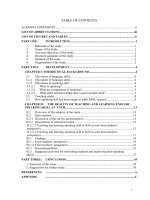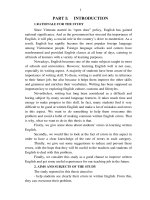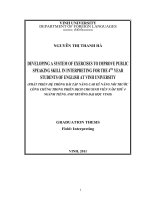Motivational changes in students of English at International School, VNU during Preparatory Programs
Bạn đang xem bản rút gọn của tài liệu. Xem và tải ngay bản đầy đủ của tài liệu tại đây (92.01 KB, 5 trang )
Motivational changes in students of English at
International School, VNU during Preparatory
Programs
Pham Thi Tuyet Mai
Trường Đại học Ngoại ngữ
Luận văn ThS. Chuyên ngành: English Teaching Methodology; Mã số: 60 14 10
Người hướng dẫn: PGS. TS. Trần Xuân Điệp
Năm bảo vệ: 2011
Abstract: In an attempt to investigate motivation and motivational changes among
students of Preparatory Programs at International School (IS), VNU, the main purposes
of the research were to find out (1) the current situation of being without motivation of
many students when they first come to International School, (2) causes of such a
situation, (3) changes in the levels of motivation after students have studied there for a
certain time and (4) suggestions to raise students’ levels of motivation. The subjects of
the study were 50 students and 3 teachers of Preparatory Programs. The teachers were
asked to join in an interview and students to answer a survey questionnaire. The research
reveals that for students of Preparatory Programs, instrumental motivation is far more
important than integrative motivation. Also, as the findings show, students’ levels of
motivation have changed after they have learned at IS for a certain time, many students,
from being unmotivated, have found interest and goals in learning in here, that is because
of a number of factors relating to their self-awareness, teachers’ support, learning
environment, etc. Finally, the study recommends that in order to maintain students’
interest in learning, teachers should vary teaching methods, adapt textbooks, focus on
students’ needs, provide students with a variety of appropriate tasks and activities and be
enthusiastic, friendly and tolerant as well.
Keywords: Tiếng Anh; Động lực học tập; Phương pháp giảng dạy
Content
PART I: INTRODUCTION
1. Rationale of the study
Students’ orientations and motivation to learn English sharply diverge. Harmer (2001)
contends that some have a clear goal inspired by a strong extrinsic motivation. Others have an
internal motivation that has fired them up. Others still may have a weak goal or motivation.
Students with no clear goals fail to know what they really want from learning English. As a
result, some become de-motivated. Thus, they lack a framework for assigning significance to
what they learn and it is a case for a lot of students at IS, VNU.
From a centre-sized school, International School, VNU has developed both in size and
quality with more and more students each intake every year. However, it does not necessarily
mean students have found their motivation in here. They come to IS for a variety of reasons, but
above all, IS does not take students through University Entrance Exam so it is a second chance
for the majority of those failing other Universities.
Therefore, it is a fact that when students first come to IS, many of them lose self-
confidence, either because of embarrassment of failing the university entrance exam or low level
of English or unfamiliarity with foreign teachers and so on, which makes class environment and
teacher-student relationship stressful.
Authority and lecturers at IS have gone different length to encourage students to learn,
with a hope that their students can find their confidence, and develop both instrumental and
integrative motivation. With a number of foreign lecturers, dedicated teachers, modern facilities
and student-centered methodology, students at IS have seen in themselves certain changes in
their purposes and study methods and consequently, levels of English competence. A lot of
students, from knowing nothing about English and hating the language, have become interested
in English lessons, talking to foreigners and even reading books in English.
Therefore, an analysis of their motivation and motivational changes during their study at
IS will be conducted to determine whether instrumental or integrative motivation is the
preference of IS students, thus eventually give some suggestions to make IS students more
confident and eager in their study.
2. Objectives of the study
This study is carried out to meet the following objectives:
1) Analyze the reasons why many students do not have motivation when they first come
to IS.
2) Analyze changes in the levels of motivation after students have studied there for a
certain time.
3) Offer options to raise students’ levels of motivation.
3. Scope of the study
The study only focuses on an overview of current situation of English learning among
students of Preparatory programs at IS. Students’ motivation will be analyzed with a hope to
identify reasons making those students reluctant to learn, different ways teachers use to motivate
them to eventually give some suggestions that can be useful for teachers and authority at IS to
increase students’ interest in learning English.
4. Methods of the study
To achieve the aims of the study, the researcher uses survey research and both
quantitative and qualitative methods are used in completing the following tasks:
- Collecting data for the analysis through a questionnaire from 50 students of Preparatory
Programs.
- Collecting data for the analysis through interviews from 3 teachers teaching at
Preparatory Programs.
All comments, remarks, recommendations and conclusion are based on the data analysis.
5. Design of the study
The result will be presented in three parts.
The first part, INTRODUCTION, presents the rationale, the aims, scope, methods, design
of the study and definition of key terms.
The second part, DEVELOPMENT, includes three chapter: Theoretical Background
presents concepts relevant to the topic such as definition of motivation, roles of motivation in
language learning, types of motivation, factors affecting motivation; Literature Review looks at
previous studies into motivation; and Methodology provides the methodology underlying the
research site which includes the general information about the study subjects and the situation of
motivation at IS. This chapter also focuses on the method of data collection.
The last part, CONCLUSION offers a recapitulation of the main ideas, limitations of the
study, and suggestions for further studies.
References
Benson, M.J. (1991). Attitudes and motivation towards English : A survey of Japanese
freshmen. RELC Journal, 22(1), 34-48.
Brown, H.D. (2000). Principles of language learning and teaching (4th ed.). Englewood Cliffs
NJ: Prentice-Hall.
Clement, R., Dornyei, Z., & Noel, K. A. (1994). Motivation, self-confidence, and group cohesion
in the foreign language classroom. Language learning, 44(3), 417-448.
Cook, V. 2001.Second Language Learning and Language Teaching. (3rd ed.). London:
ARNOLD.
Cottrell, S. 2001. Teaching Study Skills and Supporting Learning. Basingstoke: Palgrave
Macmillan.
Crooks, G. and Schmidt, R. 1991. Motivation: Reopening the Research Agendas. Language
Learning, 41.
Dilts, R. (1990). Changing Belief Systems with NLP, Meta Publications.
Ellis, R. 1994. The study of Second Language Acquisition. United Kingdom: Open University
Press, 509-517
Falk, J. (1978). Linguistics and language : A survey of basic concepts and implications (2nd ed.).
John Wiley and Sons.
Gardner, 1985. Social Psychology and Second Language Learning: The Role of Attitudes and
Motivation. London: ARNOLD.
Gardner, R.C. and Lambert, W.E. 1972. Attitudes and Motivation in Second Language Learning.
Rowley: Newbury House Publishers.
Gardner, R.C Day, and Tremblay, P.F. 1994. ‘ On Motivation, Research Agendas, and
Theoretical Framework.’ Modern Language Journal 78.
Gibbs, G. (1992). Improving the Quality of Student Learning. Bristol: Technical and Educational
Services.
Harmer, J. 2001. The Practice of English Language Teaching (3rd ed). London: Longman
Hyland, K. (1997). Language attitudes at the handover: communication and identity in 1997
Hong Kong. English World-Wide, 18(2), 191-210.
Lambert, W.E. (1974). Culture and language as factors in learning and education. In F. E.
Aboud & R.D. Meade (Eds.). Cultural Factors in Learning and Education. Bellingham,
Washington: Fifth Western Washington Symposium on Learning.
Lepper, M.R. (1998). A whole much less than the sum of its parts. American Psychologist, 53,
675-676.
Littlewood, W. (1995). Foreign and Second Language Learning. Cambridge:CUP.
Lukmani, Y.M. (1972). Motivation to learn and language proficiency. Language Learning, 22,
261-273.
Oxford, R.L. & Shearin, J. (1994). Language learning motivation: expanding the theoretical
framework. Modern Language Journal, 78, 12-28.
Wlodwoski, R. J. (1985). Enhancing adult motivation to learn. San Fransisco: Jossey Bass.









